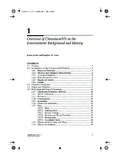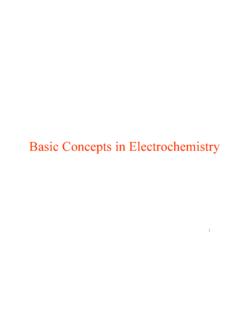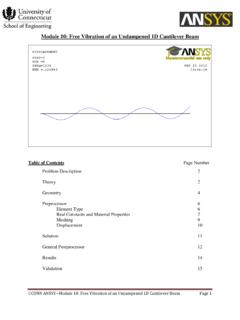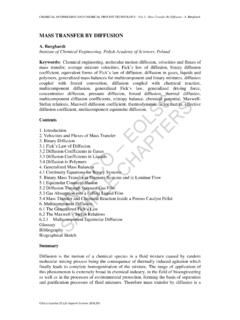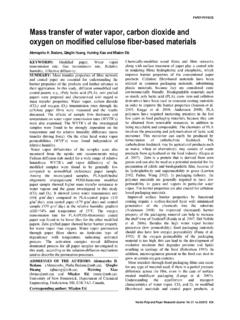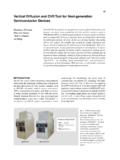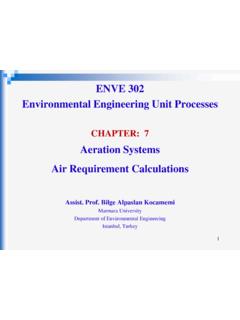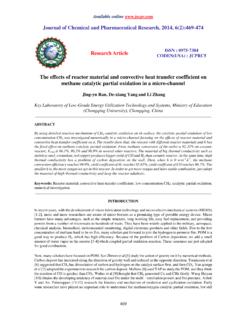Transcription of Heat Transfer Modeling - School of Engineering
1 heat Transfer Modeling Introductory FLUENT Training 2006 ANSYS, Inc. All rights reserved. ANSYS, Inc. Proprietary Introductory FLUENT Notes Fluent User Services Center FLUENT December 2006 Outline Energy Equation Wall Boundary Conditions Conjugate heat Transfer Thin and two-sided walls Natural Convection Radiation Models Reporting - Export 2006 ANSYS, Inc. All rights reserved. 7-2 ANSYS, Inc. Proprietary Introductory FLUENT Notes Fluent User Services Center FLUENT December 2006 Energy Equation Introduction Energy transport equation: ( E ). t [ ] . + V ( E + p ) = k eff T h j J j + eff V ( ) . + Sh j . Conduction Species Viscous Diffusion Dissipation Energy E per unit mass is defined as: p V2. E = h +.
2 2. Pressure work and kinetic energy are always accounted for with compressible flows or when using the density-based solvers. For the pressure-based solver, they are omitted and can be added through the text command: Define/models/energy? 2006 ANSYS, Inc. All rights reserved. 7-3 ANSYS, Inc. Proprietary Introductory FLUENT Notes Fluent User Services Center FLUENT December 2006 Energy Equation Terms Viscous Dissipation Energy source due to viscous ( ). dissipation: eff V. z Also called viscous heating. z Important when viscous shear in fluid is large ( lubrication) and/or in high-velocity compressible flows. z Often negligible Not included by default in the pressure-based solver. Always included in the density- based solver.
3 Z Important when the Brinkman number approaches or exceeds unity: U e2. Br =. k T. 2006 ANSYS, Inc. All rights reserved. 7-4 ANSYS, Inc. Proprietary Introductory FLUENT Notes Fluent User Services Center FLUENT December 2006 Energy Equation Terms Species Diffusion Energy source due to species diffusion included for multiple species flows.. h j J j .. j . z Includes the effect of enthalpy transport due to species diffusion z Always included in the density- based solver. z Can be disabled in the pressure- based solver. 2006 ANSYS, Inc. All rights reserved. 7-5 ANSYS, Inc. Proprietary Introductory FLUENT Notes Fluent User Services Center FLUENT December 2006 Energy Equation Terms (3). Energy source due to chemical reaction is included for reacting flows.
4 Z Enthalpy of formation of all species. z Volumetric rate of creation of all species. Energy source due to radiation includes radiation source terms. Interphase energy source: z Includes heat Transfer between continuous and discrete phase z DPM, spray, particles . ( E ). t [ . ]. + V ( E + p ) = keff T h j J j + eff V ( ).. + Sh j . 2006 ANSYS, Inc. All rights reserved. 7-6 ANSYS, Inc. Proprietary Introductory FLUENT Notes Fluent User Services Center FLUENT December 2006 Energy Equation for Solid Regions Ability to compute conduction of heat through solids ( h ). Energy equation: t ( ). + V h = (k T ) + S h z H is the sensible enthalpy: T. h = c p dT. Tref Anisotropic conductivity in solids (pressure-based solver only).
5 (kij T ). 2006 ANSYS, Inc. All rights reserved. 7-7 ANSYS, Inc. Proprietary Introductory FLUENT Notes Fluent User Services Center FLUENT December 2006 Wall Boundary Conditions Five thermal conditions Radiation z heat Transfer from exterior of model z Requires external emissivity and external radiation temperature. Mixed z Combined Convection and External Radiation Boundary Conditions Wall material and thickness can be defined for 1D or shell conduction calculations. heat Transfer calculations. 2006 ANSYS, Inc. All rights reserved. 7-8 ANSYS, Inc. Proprietary Introductory FLUENT Notes Fluent User Services Center FLUENT December 2006 Conjugate heat Transfer Ability to compute conduction of heat through solids, coupled with convective heat Transfer in fluid.
6 The Coupled boundary condition is available to any wall zone which separates two cell zones. Grid Velocity vectors Temperature contours Example -- Cooling Flow over Fuel Rods 2006 ANSYS, Inc. All rights reserved. 7-9 ANSYS, Inc. Proprietary Introductory FLUENT Notes Fluent User Services Center FLUENT December 2006 Conjugate heat Transfer Example Symmetry Planes Air Outlet Top wall (externally cooled). h = W/m2 K. T = 298 K. Electronic Chip (one half is modeled). Air inlet k = W/m K. V = m/s Q = 2 Watts T = 298 K. Circuit board (externally cooled). k = W/m K. h = W/m2 K. T = 298 K. 2006 ANSYS, Inc. All rights reserved. 7-10 ANSYS, Inc. Proprietary Introductory FLUENT Notes Fluent User Services Center FLUENT December 2006 Example 3D Mesh and BC's Convection boundary Flow Air (fluid zone) W/m2 K.
7 Direction 298 K free stream temp Board Chip (solid zone) Convection Boundary (solid zone) 2 Watts source W/m2 K. 298 K free stream temp. 2006 ANSYS, Inc. All rights reserved. 7-11 ANSYS, Inc. Proprietary Introductory FLUENT Notes Fluent User Services Center FLUENT December 2006 Problem Setup heat Source 2006 ANSYS, Inc. All rights reserved. 7-12 ANSYS, Inc. Proprietary Introductory FLUENT Notes Fluent User Services Center FLUENT December 2006 Temperature Distribution (Front and Top View). Convection boundary Air (fluid zone) W/m2 K. Flow 298 K free stream temp direction Front View Board Convection Boundary (solid zone) Chip (solid zone) W/m2 K. 2 Watts source 298 K free stream temp. Flow direction Top View 2006 ANSYS, Inc.
8 All rights reserved. 7-13 ANSYS, Inc. Proprietary Introductory FLUENT Notes Fluent User Services Center FLUENT December 2006 Conjugate heat Transfer Setup 2006 ANSYS, Inc. All rights reserved. 7-14 ANSYS, Inc. Proprietary Introductory FLUENT Notes Fluent User Services Center FLUENT December 2006 Alternate Modeling Strategies An alternate treatment of the board surface would be to model it as a wall with specified thickness (Thin Wall model). In this case, there would be no need to mesh the lower solid zone (representing the board). 2006 ANSYS, Inc. All rights reserved. 7-15 ANSYS, Inc. Proprietary Introductory FLUENT Notes Fluent User Services Center FLUENT December 2006 Two Approaches for Wall heat Transfer Meshed wall Fluid zone Wall zone z Energy equation is solved in a solid (with shadow).
9 Zone representing the wall. Solid zone z Wall thickness must be meshed. Wall thermal resistance directly accounted for in the Energy equation; Through- z This is the most accurate approach thickness temperature distribution is but requires more meshing effort. calculated. z Always uses the coupled thermal Bidirectional heat conduction is boundary condition since there are calculated. cells on both sides of the wall. Thin wall Wall zone Fluid zone z Artificially models the thickness of (no shadow). the wall (specified on the wall BC Wall thermal resistance calculated using panel). artificial wall thickness and material type. Through-thickness temperature z Uses the coupled thermal boundary distribution is assumed to be linear.
10 Condition only for internal walls. Conduction only calculated in the wall- normal direction. 2006 ANSYS, Inc. All rights reserved. 7-16 ANSYS, Inc. Proprietary Introductory FLUENT Notes Fluent User Services Center FLUENT December 2006 Temperature Definitions for Thin Wall Model Thin wall model applies normal conduction only (no in-plane conduction) and no actual cells are created. Wall thermal boundary condition is applied at the outer layer Static temperature (cell value) Wall temperature (outer surface). Thin wall (no mesh). Thermal boundary Wall temperature condition on wall (inner surface). 2006 ANSYS, Inc. All rights reserved. 7-17 ANSYS, Inc. Proprietary Introductory FLUENT Notes Fluent User Services Center FLUENT December 2006 Shell Conduction Option for Wall heat Transfer The shell conduction option is used to enable in-plane conduction calculations.
